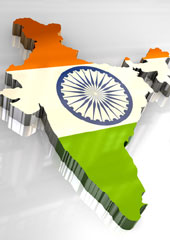India’s Modern Economic History: A Brief Review
Has India pursued policies of economic growth without adequately ensuring the gains are fairly shared?
September 3, 2012

India’s emergence into independence in 1947 came with a host of problems. The most fundamental ones were widespread poverty and a chronic lack of resources. In addressing this dual developmental challenge, policymakers at the time had two ideological pathways to choose from.
The Gandhians advocated self-sufficient but empowered village communities as the basis for the new nation. Others believed that modern technology and industry would transform the economy. In its search for inclusive growth, the fledgling nation’s policies sought to reconcile these varying ideological strands into a coherent developmental model.
In the early 1950s, India seized on a mixed economic growth model, attempting to balance the role of the market with that of the state.
At the time, this model was seen as an answer to the challenge posed by the communist developmental model in China. India’s model offered a non-capitalist (and yet non-communist) pathway to development and social democracy to the global south.
By the 1970s, India was seen by many as an example of everything gone wrong. A “scarcity mindset” and complex bureaucratic processes that stifled entrepreneurship had resulted in decades of slow economic growth.
At the same time, the much sought social justice remained elusive with millions of Indians remaining abjectly poor. Slow growth and persistent poverty seemed to show the failure of the mixed growth model.
At the beginning of the new millennium, India’s economic policies were overhauled. The country was soon hailed by the Western media as the poster child of political democracy and liberal economics, a star performer with the potential to compete with China on economic grounds.
Looked at more closely, India’s post-independence growth story is a nuanced picture of spectacular successes in the political sphere combined with unforgivable social failure.
Most Western nations became functional democracies only once they had achieved an income of about $2,500 per capita. Upon its founding in 1947, India showed that it was possible to maintain, sustain and strengthen a functional democracy at a level of $100 per capita.
Since then, India’s per capita income has grown ten times in the past six decades and its democracy continues to thrive and mature. Yet this is still a flawed achievement because of India’s failure to address mass poverty, inequality, destitution and discrimination.
India’s Constitution and all its Five-Year Plans — the country is currently on the 12th such plan — list equality and inclusiveness amongst the most important goals. The official formula was a rapid increase in living standards, full employment at an adequate wage and a reduction in inequality.
However, that broad goal of inclusive growth would necessarily have required redistribution of income and of accumulated wealth. This vital step however, was considered impractical and politically inexpedient.
In addition, the leadership of the Congress Party, for all its reputation to be “in” with the little man, as far back as 1949 passed constitutional provisions that sustained State control over land and limited the redistribution of land and other property. Redistribution would have met opposition from the wealthy, nascent entrepreneurs, as well as from the propertied castes in rural areas.
These are the very groups who continue to command the personal financial resources to run for political office. To this day, a large majority of legislators are drawn from their ranks.
In contrast, landless laborers, tenant farmers and small cultivators — though constituting a vast majority of the population — could not stand as a candidate for office. That remains pretty much true to this day,
Thus, limited state capacities — combined with political expediency and the traditional castes’ hold over social and economic power — has kept the poor economically marginalized.
For all the lip service paid by successive governments and their Five-Year plans to the idea of inclusive growth, policy has remained guided by the hope that high economic growth, and the consequent generation of wealth, would somehow trickle down to the poor masses.
A comparison with Mexico since 1980 is instructive. Though India has enjoyed higher growth rates than Mexico for three decades, its per capita GDP in 2008 was equal to that in Mexico in the 1950s.
That is not a happy indicator for India. Neither is the fact that, even by the Indian government’s most optimistic estimates, at least 28-30% of Indians still live in abject poverty. The Indian Planning Commission, which defines poverty using calorific value of food intake, similarly estimates that around 27% of the population lives below the poverty line.
The World Bank’s international poverty line of $1.25 per day suggests a higher number of poor, finding that 42% of the Indian population below the poverty line.
However, these numbers almost certainly fall short of the reality. Closer to the truth is a 2007 report by the National Commission on Enterprises in the Unorganized Sector (also known as the Arjun Sengupta Commission Report) that estimated that only 235 million people were able to meet their own economic needs.
This suggests that the other 836 million Indians — or 77% of the population — had incomes of less than $2 per day and needed government support. Given that only 10-12% of the Indian labor force is employed in the organized (formal) sector, this figure may be the most accurate.
In terms of income inequality, India was close to industrialized countries in the early 1990s, but is now becoming increasingly imbalanced and closer to that seen in China.
Specifically, after the market-friendly reforms in the 1990s, the consumption of the top 20% of the population rose remarkably. In contrast, that of the bottom 80% of the rural population declined.
In another telling illustration, Raghuram Rajan, the University of Chicago economist who has just been appointed as a chief economic advisor to the Indian government, has pointed out India’s dubious distinction of having the second-largest number of billionaires per trillion dollars of GDP, behind Russia.
Indian billionaires hold more than 31% of the national income, four times higher than the global average.
The Indian anthropologist Arjun Appadurai, now at New York University, has argued that “the project of wealth creation has become radically unhinged from the project of poverty alleviation and social inclusion. The development state still exists in India, but it is vast rent-gathering apparatus which is there to assure that the poor are not in the way of massive capitalist development.”
At present, concern over the persistence of poverty and inequality is growing in India. But dealing with this challenge is constrained by fears that tackling inequality for real may frustrate economic growth.
Editor’s note: This essay was adapted from the author’s presentation at the 2012 Salzburg Trilogue. Hosted by the Bertelsmann Stiftung, the Salzburg Trilogue facilitates international cultural dialogue by bringing together recognized public figures to consider matters of global importance.
Takeaways
India's post-independence growth story is a nuanced picture of spectacular successes in the political sphere combined with unforgivable social failure.
Inclusive growth would necessarily have required redistribution of income and of accumulated wealth.
Though India has enjoyed higher growth rates than Mexico for three decades, its per capita GDP in 2008 was equal to that in Mexico in the 1950s.
India has the dubious distinction of having the second-largest number of billionaires per trillion dollars of GDP, behind Russia.
Read previous
Norbert Walter — An Appreciation
September 1, 2012
